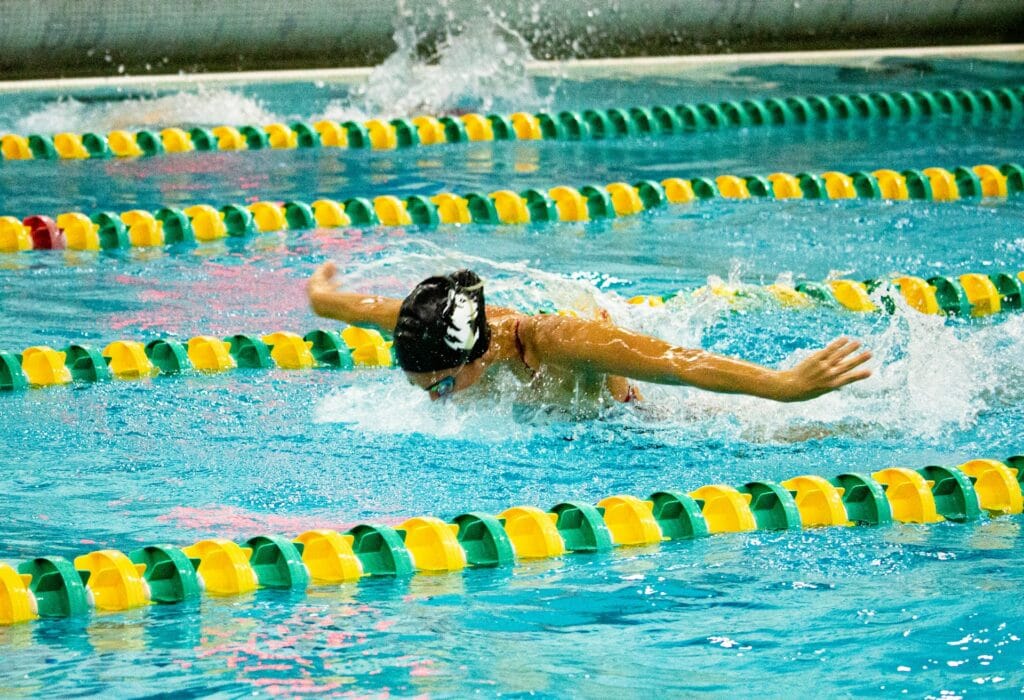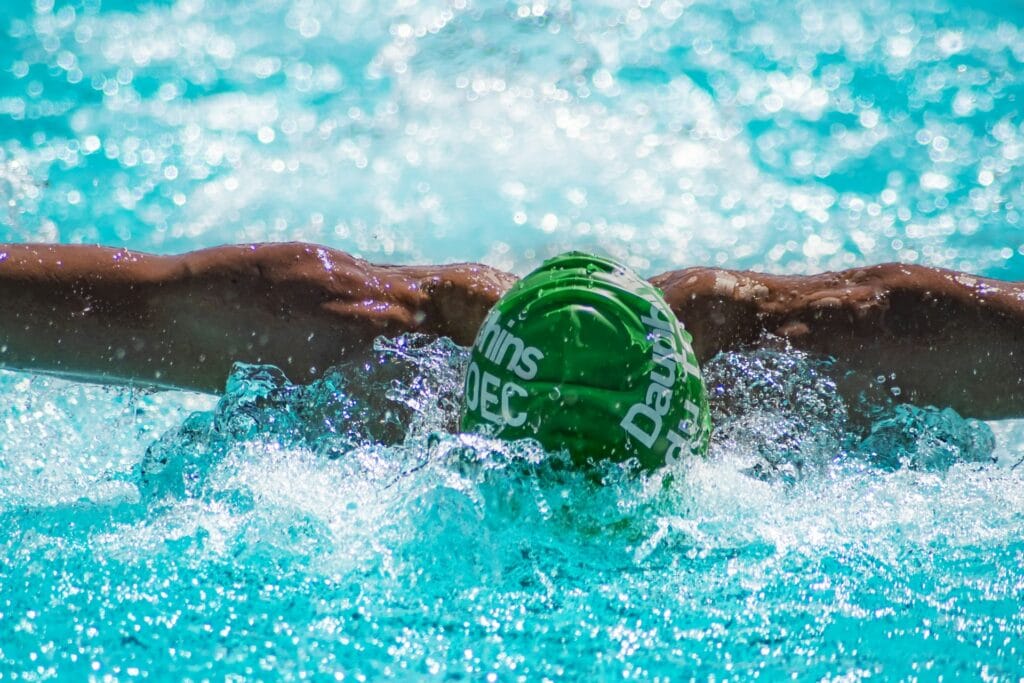Learn about What is Butterfly in Swimming. Discover the butterfly stroke in swimming, known for its powerful arm movements and dolphin kick. Learn its history, benefits, technique, and how it improves speed, flexibility, and endurance.
Butterfly stroke is perhaps the most physically demanding and technically difficult swimming stroke. Strong arm strokes, coordinated dolphin kicks, and body undulation constitute this style, which happens to be one of the fastest strokes in competitive swimming.
The very character of these challenges necessitates exceptional locomotor skills, strength, and endurance, all worthy of respect from aspiring elite and any individual wishing to hone their skills technique-wise.
What is Butterfly in Swimming?
A powerful arm movement and a dolphin-like kick are the prime characteristics of this swimming stroke: The arms become very powerful and forceful, the legs dolphin kick in cadence, and the body rides a wave-like motion created out of the harmony of both arm and leg movement known to push water. As one of the fighting strokes, endurance, power coordination are a must.
History of the Butterfly Stroke
Origins and Development
The butterfly stroke emerged in the 1930s in the form of an adaptation of the breaststroke. This was when swimmers would still utilize the overarm recovery motion while still doing the traditional breastroke kick. By the time of the introduction of the dolphin kick, however, somewhere in the 1950s, the butterfly had become an entirely different stroke.

Inclusion in Competitive Swimming
The butterfly was thus recognized as a distinct stroke apart from breaststroke by the International Swimming Federation (FINA) in 1952. Since then, butterfly has come to be one of the four swimming strokes: the others being freestyle, backstroke, and breaststroke.
Benefits of the Butterfly in swimming
- Full-Body Workout: It works out all muscle groups such as arms, core, and legs and gives a complete workout-effective strength and endurance improving workhouse.
- Improves Speed: With large arm and leg movement, the swimmer is guaranteed to build up some speed and agility.
- Enhances Flexibility: The stroke is effective in relieving tension in the body by relaxing muscle groups, especially those in the shoulders, hips, and ankles, and can be used to execute many various strokes.
- Boosts Cardiovascular Health: This stroke may just be the most difficult of the swimming styles, putting needs on the cardiovascular system, thereby reaping the benefits of heart and endurance-building, perhaps even in the long term.
- Builds Coordination: In this, the timing and coordination of the arms and legs with breath constitute an advanced sense of body control and rhythm in the water.
The Importance of Flexibility in Butterfly Swimming
Flexibility of butterfly swimming skills becomes an important factor, since the shoulder, hip, and ankle joints should be flexible ways to achieve effective ranges of motion. Flexibility cannot achieve it alone, but with stretch routines, yoga, and dynamic mobilities, stroke efficiency and injury prevention improve.
Technique and Execution
1. Body Position
Sculling should be kept as flat as possible on the water surface, with minimal undulation and movement. Correct body positioning minimizes resistance while maximizing efficiency for the stroke.
2. Arm Movement
The arm movement in the butterfly stroke follows a specific cycle:
- Entry: Hands enter the water shoulder-width apart.
- Pull: Arms move outward, then inward in a sweeping motion.
- Recovery: Arms exit the water simultaneously and swing forward.
3. Kick Technique
The dolphin kick technique, which is what a swimmer will use in the butterfly stroke, has legs that are fluid and wave-like. The legs of swimmers, who would use this technique, perform two kicks for each stroke: one when the arms are pulled, and another when they’re recovered.
4. Breathing Technique
Swimmers tend to breathe every stroke or every second stroke, lifting their heads slightly above the water level during the arm pull. Breathing should be as efficient as possible, enabling him to swim in rhythm with a minimum drag factor.
Common Mistakes and How to Avoid Them
- Incorrect Timing – A harmony of arm movements with kicks is lost with poor synchrony. Drills, in turn, can help cultivate timing.
- Lifting the Head Too High – An increase in drag comes from excessive lifting of the head during breathing. If the head is kept low and forward, flow will be enhanced.
- Overexertion – Often, novice swimmers use a lot of energy. Concentrating on technique saves energy and improves performance rather than just using brute force.
Common Mistakes in the Butterfly Stroke
Poor Timing
Poor timing of the arms and legs in the butterfly stroke disrupts the swimmer’s rhythm, imperfectly propelling the body forward, causing increased drag. Proper coordination of the arms and legs helps create smooth, even jet-propelled motion through the water.
Incorrect Breathing
Any raising of the head above water with discomfort could create some resistance as well, not helping the swimmer’s speed. The swimmer should stay as streamlined as possible, synchronizing the breath with the stroke to ease drag and maximize speed.
Inefficient Kick
A weak or poorly executed dolphin kick decreases propulsion and energy. Instead, the kick should generate a rhythm from the hip, intensely and fluidly driving the body forward, netting speed and reducing fatigue throughout the race.
Competitive Butterfly Swimming
Butterfly is an attacking stroke for the distance events 50m, 100m, and 200m butterfly, and for individual medley. The swimmers, such as Michael Phelps, have broken records worldwide, paving the way for other techniques and strengths to mimic them.

Cons of Butterfly Stroke
- Physically Demanding: Butterfly usage requires huge energy and stamina; it tires swimmers out more than anything long-distance swimming or long practice usually brings.
- Difficult to Master: Highly coordinated actions having a good deal of strength and technique are essential for the stroke, making it difficult to learn and execute correctly by novices.
- High Risk of Injury: When done improperly, most of the body movements associated with the butterfly-including the shoulders and lower back-are those that often
- Limited Efficiency for Long Distances: The butterfly is fast, but it also consumes a lot more energy than other strokes, such as freestyle, over long distances, which tires faster.
FAQs
Can beginners learn the butterfly stroke?
Newbies can indeed learn the butterfly stroke. With gradual strength building and technique development, they ought to be able to eventually lift their heads high enough in perfect execution of the complete stroke.
What muscles does the butterfly stroke work?
The butterfly employs major muscle groups such as shoulder, chest, core, and legs, and hence from a workout point of view, should stimulate strength and endurance across the whole body.
Is the butterfly stroke the hardest swimming stroke?
Yes, in technical and energy requirements, butterfly is considered the most challenging due to the numerous things occurring at the same time; that is, everything must be coordinated perfectly from arms, legs, and time of breathing.
Conclusion
The butterfly stroke is considered the most difficult and yet most splendid stroke. Strength, coordination, and endurance are required. Strengthens the body and cardiovascular system; increases flexibility and speed. Training and perfecting the style also contribute directly to other swimming skills, which becomes a huge asset for competitive swimming.
